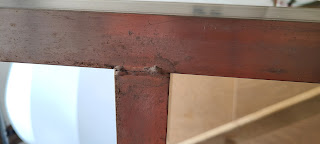I finally finished painting the mega axle with two coats of black enamel paint, which included painting inside the cross axle square tube. Painting inside a tube was an old trick using a sponge and a coat-hanger. It was messy, but functional. Now the axle is fully painted and bolted onto the trailer frame.
Moving on to torsion. I've been disappointed at the low torsional stiffness. Adding the side-walls was very helpful, but I can stand on the back corner of the frame and see everything flex, including the walls. I see the main beams twist slightly One idea was to add more parallel frames beneath the floor (which also doubles up support for the plywood floor). The last good idea was to add a top lid of trusses.
Some previous experimentation clamping spare angle across the top seemed plausible, but didn't give enough improvement. Today, I clamped three eight-foot 2x4's as trusses across the open top. Those were instant magic for increasing the torsional rigidity. I can literally stand on the back corner and the front of the frame stays stiff. Amazing. This finally puts a finger on the right next step.

I took a drive around the neighborhood with the three 2x4's clamped across the top (this was the first real drive with the torsion axles too). Driving was better, though the long unsupported upper rail on the front was quite wobbly. After stopping to inspect, one of my original frame welds had broken, which let the vertical strut start to flex. That's fixable. It also suggests that adding more cross-frames may help more than I realize, since not having just one weld made such a difference. Lastly, it also means I really must weld all of the inner joints rather than just the upper flange. For another day...

Also of note, TIG welding thick aluminum had been getting more frustrating. At 180A, the tungsten tip was melting (green) or exploding into nodules (blue), which meant re-sharpening the tungsten literally every weld. After watching several tutorials from the excellent Pacific Arc Tig Welding channel on Youtube, it appeared my AC balance of 30% was too much cleaning action for an air-cooled 3/32" tungsten. My Weldpro only goes down to 30% balance, so decreasing further was not an option. After watching several more tutorials, today I finally tried the second idea of increasing the AC frequency. Going from 60Hz to 120Hz did seem to make a difference, and I was able to weld longer without melting the tungsten tip nearly as much. Hopefully I can keep experimenting with this trick during finish welding.
Before driving around the neighborhood, I repaired the broken wires
on the left tail light. The road literally ground a hole the plastic,
so this LED light is probably fine for a bit, but will die a slow death
from corrosion.
Oh! I'm pretty sure I found a field for a first flight. Blackstone Army Airfield (KBKT) is uncontrolled on the weekends and has a 5,000ft x 300ft dead runway that is perfect for both driving on and doing a takeoff and landing. Most airfields are not cool driving a car on their beautifully manicured grass runways (for good reason), or the paved runway is active for general aviation traffic. According to the airport owner, so long as I have an air-band radio, I should be good to do the maiden flight there. He has had other ultralights fly from the field, so there is even precedent. Hopefully this ends the search saga. It is a three-hour drive to get there, and will be even slower when towing a trailer I do not yet trust to go around the neighborhood. One day at a time. At least this is non-zero progress!
Trailer to do's are now:
paint axle assembly with some enamel paintrepair left tail-light wiring
- buy more Argon gas
- finish weld the vertical elements
- epoxy-coat seal the ply decking
- install and wire running lights on the sides
- add reflective tape on the sides
- create a rear door that can be quick-pinned in place
- figure out front/side/back walls
- dream up a top lid
- figure out how Goat parts sit in the trailer
- take all of Goat for its first trip around the neighborhood
- be comfortable driving six hours at highway speeds
For the first-flight:
- backyard final assembly and thorough pre-flight check, including weight & balance
- re-weld the tow hitch release (I'm now doubtful it had good penetration)
- buy tow rope, weak-links, and end rings
- buy/borrow radios (1x airborne, 1x car)
find a place to fly- travel
- fly
After the first-flight:
- add leather patch to wing tips where will rub the ground
- install leather patch guides for elevator control lines
- paint trim color
- install wing root kiss seal
- build a wing tip dolly
- build a wing wheel
- jury strut fairings
- main strut fairings (after flying to figure out the right angles)
- emergency parachute
- real variometer (LXNav with a TEK probe is my intention, if it is sensitive at low speed...)
- drogue chute

















































